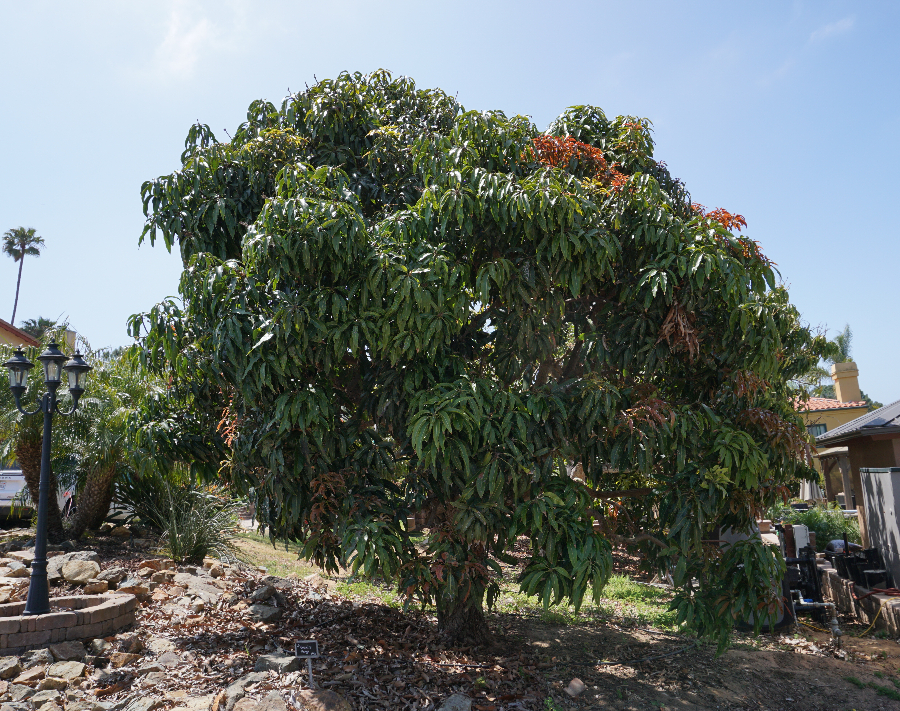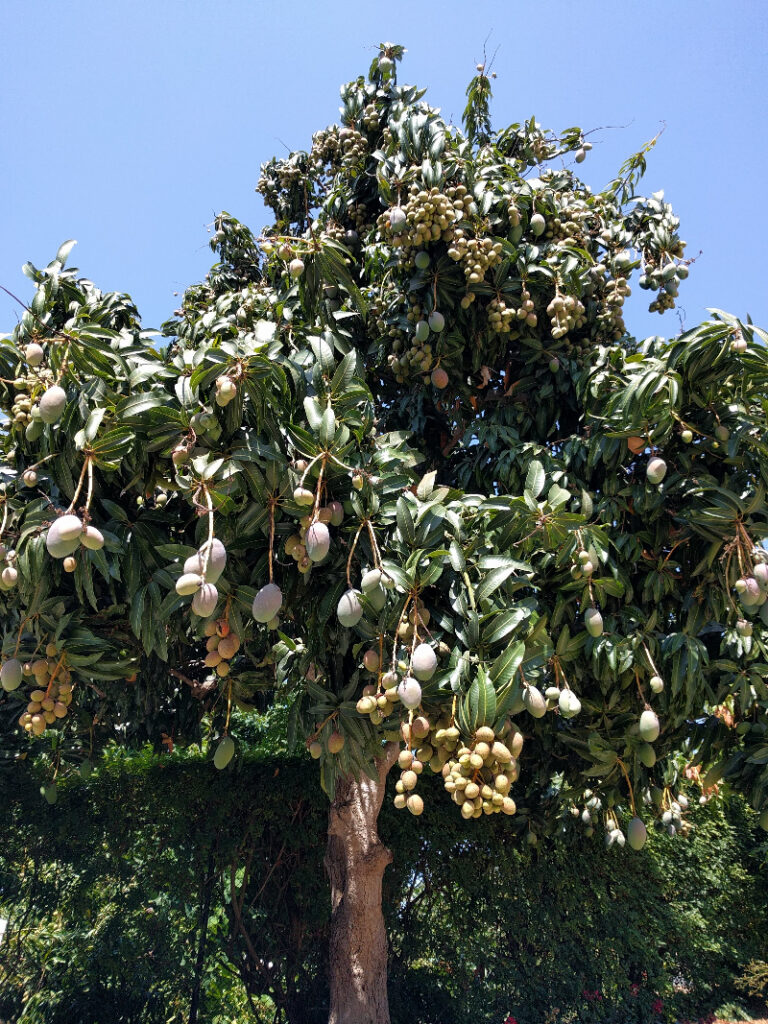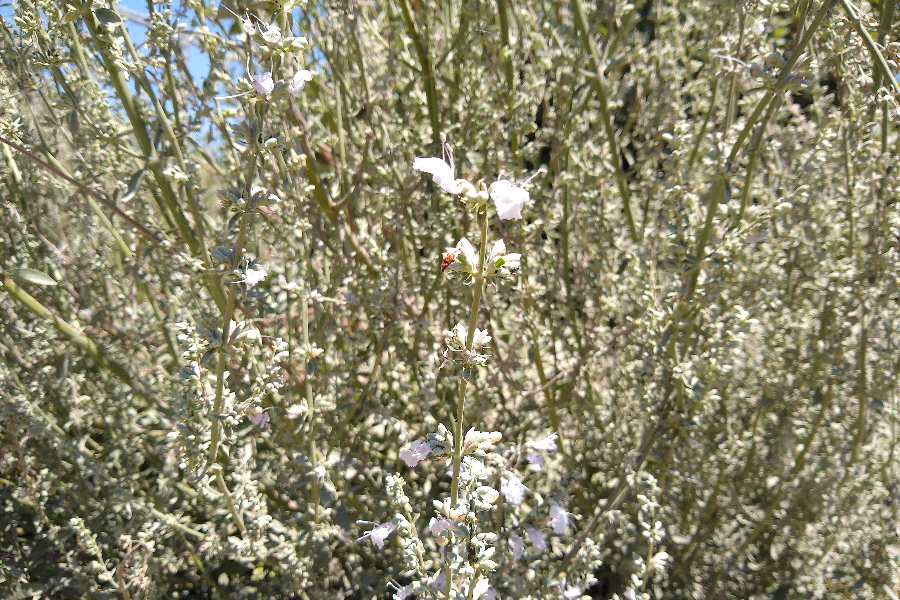Nick and Anna-Marie told me they had planted a white sage in their backyard, and the plant’s tag said it was a “compact” version but it had grown over five feet tall and wide.
I looked out their back door to see the plant. There it was: A robust white sage with flower spikes extending as far as any wild one I’ve seen on our Southern California hills.
Nick said he had heard a phrase that sums up a situation like this: “Plants don’t read books.”
That’s a perfect way to capture it. The problem is that we do.
We read on a plant tag or in a book or hear on a gardening podcast or watch on a video that a certain plant is supposed to act in a certain way, and then we expect to see that. But plants don’t always follow what’s been written about them; in fact, they don’t even know what’s been written about them.
In 1954, the first edition of the Sunset Western Garden Book was published. Its entry about growing mango trees in California reads: “Mango: a tropical that will exist in the frost-free areas, but that is about all.”
However, Captain Bucklew had already been growing mangos for almost twenty years, and by 1956 was up to 172 mango trees on his property in Encinitas, and some were doing more than merely existing. Even today, after nearly a century, some of Bucklew’s mango trees continue to flourish.

Paul Thomson, co-founder of the California Rare Fruit Growers, started growing mangos on a property he purchased in Vista in the 1960s, just after the publication of the Sunset Western Garden Book, and some of those trees grew up to fruit very well and continue to do so today.

Good thing these trees hadn’t learned that they weren’t able to do much more than exist, and good thing that Bucklew and Thomson gave them a shot and let the trees speak for themselves.
We must take reality as it is. When our eyeballs present to us something contradictory to what we’ve read or heard, we must believe our eyeballs.
This is not as easy as it sounds. Sometimes I find myself unable to immediately process something I’m observing in my yard because it doesn’t comport with what I’ve been primed to see.
Our fight as food gardeners is to hear what the plants are saying to us, unfiltered. And what the weather is saying, and the birds and the bees and the bugs. And the soil.

My friends with the illiterate white sage, Nick and Anna-Marie, have bought a piece of land on which they’ll be building a house and developing a food garden. I met them at the property last month to check it out. They told me about their house plans and planting plans as we strolled through. I looked at the weeds and the native plants, and I looked at the dirt.
I wondered what the United States Department of Agriculture’s Web Soil Survey had to say about the dirt in this area so when I got home I looked it up. The Web Soil Survey classified the parcel’s soil as “Placentia sandy loam.” Sandy loam is a pleasant soil type to work with. Nick had already done a jar test with the soil, and I had felt some of the dirt in my hand while at the property. The jar test and my hand test both indicated a sandy loam too.
But the survey went on to say that this soil in this parcel has a thick layer of clay only 13 inches below the sandy loam. I texted Nick about the layer of clay: “Avocado trees especially would appreciate being planted on slight mounds if you dig and find that true.”
Then I paused to think. What had I seen with my own eyes? At one point during the visit to the land, we had stood next to a trench dug a couple feet deep for a water line, and I recalled that I had seen no clay layer in that trench. It was sandy loam all the way down.
Remember that? I texted Nick. Maybe the USDA Web Soil Survey is wrong?
“Shovel don’t lie!” he wrote back.
All of my Yard Posts are listed HERE
I hope you enjoy my Yard Posts. Thank you for the support so I can keep them ad-free.




I’m in Lakeside, and my mango that was looking pretty good over the summer died from frost this winter (along with a lime and two plumerias). Was ice cream mango the wrong kind to choose? Does he cover his when they’re young?
I read in a book that I had a clay layer too! But the mason jar test said loamy sand, and another one two feet down was just sand. So it seems rumors of the southwestern clay layer were greatly exaggerated!
Hi Jessica,
That’s funny that you had a similar experience with the clay layer. I wonder how this error occurred and how widespread it is.
This wasn’t a good winter and spring for mangos around Southern California. One of my small ones died and another died back halfway. I’ve seen some in other yards that still look good but I’ve also seen some that have died back partly even though they’re as tall as a person.
Yes, I think it is key in certain locations (like mine) to protect baby mangos through their first few winters.
Thank you for the reply! That gives me enough hope to try another mango. I used your incandescent Christmas light suggestion on my avocados this winter (planted spring 2022), and it seemed to work really well. I used a $20 greenhouse controller that turned them on when the temperature got under 40°. I’ll try that method if I get another mango. I’m so irritated with myself for not paying more attention and covering it.
I read in the book Extreme Gardening that low desert southwest has a clay layer 3 feet down, so it seems to be a pervasive idea, but I have no idea where it came from. I might technically not be low desert though. But either way it’s a good reminder to always verify things!
I planted 3 mangos in 2004. We had a pretty good frost that year. One was killed by frost, one froze down to 2 inches above the graft (and slowly recovered), the third showed no damage. Subsequent mango plantings along with those two survivors have shown no damage despite a few frosts. Conclusion: Damage may depend partly on where the tree is in your garden, but it’s likely all very young mango trees would benefit from extra protection their first two years or so.
That year I had two Keitt trees side by side, one 5 years old, the other 2 years old (planted 2002). The younger one lost a few leaves to frost, the older one was unaffected.
Thank you, that’s very helpful! I thought I had chosen the warmest spot on the property, a few feet from the pool/pool deck near the southern edge of my yard, but either I didn’t or we get way more frost than weather averages from the web would suggest– my bananas all lost all their leaves, the mango and two plumerias died, and my passionfruit vine looked sickly until recently. I also lost a lime in the front yard. I think it didn’t help that there wasn’t enough organic matter in the soil, at least for the passionfruit and lime. I fertilized the bananas all summer, but I know they’re heavy feeders. The passionfruit seemed to perk up quite a bit with several feedings. With anything I put in this summer, I’m going to make more effort to spread some compost, top soil, or plant tone under the mulch.
About your new beehive…. My next door neighbor had hives on his back slope, which was covered with fruit trees. One fine day people were walking by on the sidewalk out front, and began screaming. They were being stung, many bees in the air. The next people came by, and I went out to warn them before they entered the swarm area. I got stung 5 times, and was very concerned because I am allergic to bee stings. But this time, nothing happened. Then I realized the 2 Benadryl tablets I take every night for insomnia protected me. I suggest anyone dealing with bees keep some Benadryl anti-allergy tabs on hand. (My neighbor had improperly moved his hives, causing the stir.)
Our atulfo mango did very well this winter but our solo papayas about died and are now putting out a bunch of leaves and dropping all the winter fruit. We had three cocos that lived for six years but two died and one is on life support. Our star fruit is putting out a bunch of new leaves as is our cherimoya and atemoya. It was a tough winter but some did survive and some really didn’t notice it, like the mango.
Hi Greg
After reading the article on the new Avocado variety, “Luna” , I’m a little confused. Are Gem and Lamb Haas the same Avocado ?